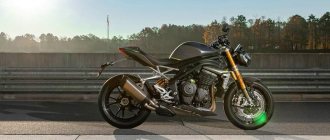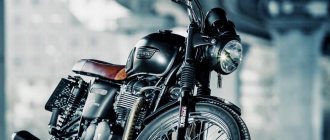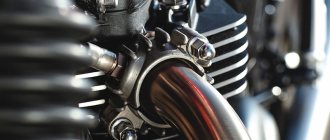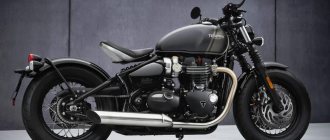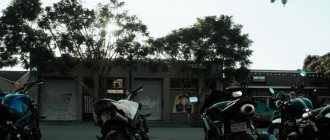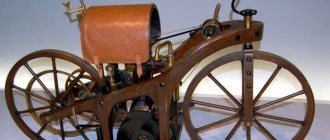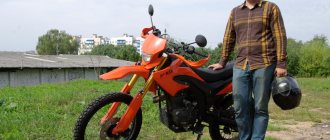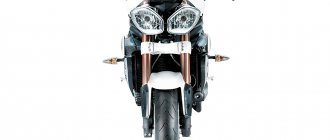TRIUMPH SPRINT ST/GT
In 2005, Triumph launched the updated “sport tourer” Sprint ST, created around a 1050 cc in-line “three” with a capacity of 12S (in fact, once again a modernized unit, the design of which originates from the early nineties). At the same time, it was obvious even to a blind person that the Hinckley factory took its number one competitor, the 2010 Honda VFR800F “sport station wagon,” as an example to follow: to run errands, to circle the track, and to boldly set off towards the horizon.
However, along with all the advantages, the “British” also adopted certain mistakes of the “Japanese” (for example, a battery of mufflers located under the saddle, which greatly limited the choice of luggage bags), which, taking into account the general trends of the motor market - less sports, more tourism - seriously affected sales figures. Therefore, already in 2010, the “street” ST was ousted from the assembly line by the “highway-long-distance” GT.
STORY
2005 The appearance of a seriously redesigned asphalt “tourist” Sprint ST with an injection in-line “three” with a volume of 1050 cm3 and a power of 125 hp, the design of which was born in the early nineties. Main features: cantilever rear wheel mount and underseat muffler.
2010 The British present a long-range version of the Sprint GT. The exhaust system moves to the right side. Side cases with a capacity of 31 liters each become part of the standard equipment. The aluminum subframe has been replaced with a more durable steel one. The monoshock absorber has remote spring preload adjustment. The swingarm grows in length, which increases the wheelbase to 1565 mm (+95 mm). But the engine becomes more powerful by 5 hp. The ST variant disappears from the brand's showrooms at the end of the year.
2013 To stir up interest in the aging model, Triumph releases a special version of the GT SE, which actually displaces the “standard” from the lineup. It is distinguished by the presence of a central case (useful volume has increased to 117 liters), heated handles, a gel saddle and a high windshield. However, since 2015, the model has not been sold in all markets, and at the end of 2021 it finally retired, leaving no heir.
“Dzhitishka” was distinguished, first of all, by a muffler mounted on the right side, a set of side cases of 31 liters each, a steel subframe instead of aluminum and an elongated cantilever pendulum, as a result of which not only the issue with luggage was resolved, but at the same time there was no extra legroom at all passenger, but the wheelbase has also increased to 1S6S mm (+9S mm). Apparently, as compensation for the deteriorated maneuverability, the engine was not given an extra 5 hp.
However, there was no avalanche-like demand for the Sprint GT. So just three years later, in order to somehow draw attention to the aging “road car”, the British transformed it into a special version of the GT SE, which was de facto a “standard” with a central trunk (the useful volume increased to 117 liters), “ warm" handles, gel saddle and high windshield.
As you might guess, before the invasion of crossovers, all efforts were in vain. The Sprint family, represented by the GT version, existed until 2021, after which it retired without leaving an heir.
Ride. Always, everywhere and sometimes very far. Especially if you have been looking for a used “vyfer” for a long time for these purposes, but it was scared off by its inflated price tag. The British Sprint of both modifications is generally very close in its design to the VFR of the “Dovtek” times: grumbling, smooth, a little massive and somewhat old-fashioned. And if you like to feel the essence of a motorcycle, and not the shell of arcade games, then the ST and GT, deprived of almost all electronic assistants (ABS and fuel injection do not count) and engine modes, can truly become a “breath of fresh air” for you in a stuffy digital world.”
The best thing about it is the in-line “three” with a volume of 10S0 cm3, which has an impressive reserve of traction at the “bottoms” and sufficient for vigorous overtaking at the “tops”. The ergonomics are relaxed, with a slight forward tilt - so that you can talk about involvement in the control process and the presence of feedback on the steering wheel. But if you suddenly want to light it up, cut the steps on the serpentine road along with the sidewalls of the tires, then Sprint will instantly remind you of its “old-regime” essence: smooth and seamless control in the style of Mike Hailwood suits the “British” much better than the mad rodeo of Marc Marquez.
The presence of a passenger further emphasizes the monoshock's lack of shock damping. This is compensated for by tightening the spring preload (the GT, by the way, is equipped with remote adjustment), but only on the condition that you abandon the idea of bringing your entire house on the road. And it’s very easy to succumb to this temptation - stirrups with panniers with a total capacity of 117 liters! At the same time, you must be sure to remember the maximum permissible load - up to 215 kg on the GT, including driver and passenger.
The influence of the “old school” can be seen throughout the Sprint design.
First of all, in the in-line “three” with a volume of 1050 cm3, which is good and brutal, but requires careful maintenance. As soon as you neglect such seemingly nonsense as warming up, the engine begins to consume oil. At least until it reaches operating temperatures. If so, then in order to avoid problems with the crankshaft main bearings, it makes sense to get into the habit of checking the oil level daily.
One of the Triumph recall campaigns for the Sprint ST and GT models, by the way, related to the lubrication system: due to an error made at the factory, 200 motorcycles in 2010 were equipped with short oil dipsticks. The second time the British invited us to the service was in 2007, when some copies were found to have a faulty front master cylinder (part number T2025498). Well, the third case occurred in 2011, when the British missed the design of the fastening mechanism of the central case (part numbers T2351020 and T2353172): it did not secure the plastic suitcase tightly enough on the platform and gradually became loose, as a result of which the luggage could at some point simply catapult.
To make life easier for the engine and not risk your health with the almost inevitable risk of overheating of the light-alloy cylinder head, do not forget to clean the radiator of the cooling system at least once every two to three years. Just carry out this procedure carefully: small honeycombs are extremely delicate.
The starter overrunning clutch roller is also fragile, which can jam if you try to start the engine with the battery at zero. At best, this will lead to destruction of the starter, at worst - a total “Stalingrad” of the engine due to crushed gears and couplings. Therefore, always keep the battery fully charged and do not overdo it with the starter button if it suddenly becomes difficult for you to crank the crankshaft. A characteristic knock at the bottom of the engine will indicate that the unit is faulty or close to failure.
False neutrals and stubbornness when changing gears, which owners of “liter-fifties” Sprint ST and GT often complain about, appear mainly on untested cars and usually disappear with use. Provided, of course, that the mobility of the hinges and rods of the switching mechanism is normal, and the clutch does not jam when released, this happens. If obstinacy is still present, you can always experiment with oil viscosity within the range recommended by Triumph: 10W-40 or 15W-50, one hundred percent or semi-synthetic.
The effectiveness of the Nissin brakes (both front and rear) is barely enough for a large “tourist”. Like any mechanism, they love caress, cleaning and lubrication: road dirt, dust from pads, rust on pistons and bolts are their constant companions. In addition, from periodic overheating - try to stop flying 400-450 kg with luggage and a passenger! — caliper seals suffer. This means that the brakes need to be cleaned of dirt and oxides at every service, and in some advanced cases, they need to be rebuilt. Of course, it makes sense to replace the “stock” pads with the “evil” version with the NN index and the hoses with reinforced ones. But then you will have to accustom yourself to the fact that the first meters of the journey, while the discs and pads are cold, you need to press the growl gently. Because the inevitable consequence of haste will be warped brake discs.
As far as electrics are concerned, the most complaints come from a failing voltage regulator relay, which causes the expensive generator to die prematurely. At the end of the Sprint assembly line life, the British replaced the original part with an improved version (part number T1304040), but owners much more often vote with their wallets for the alternative relay-regulator ShinDengen SH series, which is equipped with the latest generations of Tiger 800 and Street Triple (part number T1300675) and to install it in the standard Sprint wiring you will need an adapter (part number T2500676).
Those who travel in any weather, from the first to the last snow, have noticed that the place for the optional “anti-theft” is chosen extremely poorly: moisture gets there, disabling the alarm system.
ENGINE
The roots of the in-line “three” inherited by the sports tourer Sprint ST/GT stretch back to the early nineties, when Triumph, revived by John Bloor, introduced its debut tour enduro Tiger 900. And the 1050 cc version, born in 2005, with a power of 125 hp. — this is already the third generation, obtained by increasing the piston stroke of the first injection engine with a volume of 955 cm by 6.4 mm! 1997 model. From him, the “fifty liter” also adopted the need for mandatory warming up, as well as the tendency to consume oil. The gearbox works better, but still sometimes there are false neutrals and stubbornness when shifting. One of the weak points is the starter overrunning clutch roller, which can jam if, for example, you try to start the engine with the battery at zero. What happens because the battery tends to discharge due to a capricious relay regulator.
SUSPENSION
The Showa suspension is technically simple. Among the “excesses”, the only available options are preload adjustment at the front and rear and adjustment of the rebound hydraulics on the monoshock absorber. However, even when clamped, the shock absorber still remains too soft, which is very noticeable in comparison with a rigid fork. Salvation, as always, comes in the form of new springs and valves, or a more advanced alternative (Wilbers type 640 and type 641, for example, or Ohlins STX 46 Adventure TR 703).
BRAKE SYSTEM
The brakes are generally sufficient, although they are limited. You can slightly strengthen their fleece by choosing “sadier” pads and replacing the hoses with reinforced ones. In addition, like any mechanism, Spent ST/GT brakes love caress, cleaning and lubrication: dust from the pads often sticks to the pistons with guides and jams them.
TUNING
Judging by the fact that the SE special version, which appeared in 2013, is de facto a “stuffed standard”, there are no problems with the choice of additional equipment. After all, in the company catalog there are panniers with a total capacity of 117 liters (alas, they leak), a satellite navigator (outdated and overrated), a front fender extension (saves the radiator from dirt flying from under the wheel), and a high windshield (redirects the air flow from chest to head), and a gel saddle (adds comfort). True, there is still not much there. For example, sliders for the frame or wheel axles, grille protection for the radiator, a boot cover for the monoshock absorber or an automatic chain oiler. So you definitely can’t do without third-party companies specializing in accessories for tourists.
Test drive TriumphSprint ST
The Triumph brand has always been an exception to the general rule. Its factories produced motorcycles that did not copy the achievements of competitors, but had their own individuality, formed both by original technical solutions (who does not know about the “three-cylinder” nature of Triumphs) and original design.
At the same time, thanks to the refined driving characteristics, the operation of the English “winners” brings their owners a lot of positive impressions. After successfully overcoming the crisis of the 70s - 80s of the last century, since the mid-90s, the brand has been experiencing a second youth. Unfortunately, the representatives of this glorious motorcycle family in Ukraine can still be counted on one hand, but, nevertheless, we managed to find and “ride” one of them, namely the Triumph Sprint ST sports tourer model 1998.
Opinion:
Valera DRIVE
Height: 186 cm. Weight: 118 kg
Drives: BMW R1150RT
The current owner acquired it, one might say, by chance: the previous BMW K1200RS bike, due to severe injuries received in an accident, was completely immovable and could not be restored until the end of the trial with the culprit of that terrible accident. The owner himself, who had “licked” his own wounds by the next season, accidentally came across the subject of the story in cooperative garages, could not resist the charm of Sprint and bought it.
We were able to “taste” the British only at the very end of the last season, when every day of good weather was like the last sip of life-giving nectar, maybe that’s why the motorcycle was perceived especially clearly.
First. At first glance, the bike does not impress with its appearance, but if you are greeted by your clothes, then you are greeted by completely different criteria. And the Triumph Sprint ST has a very decent level!
Second. The sound of release. This is a phenomenon that some people needlessly criticize, while others praise it with no less reverence. Indeed, while it is idling, it is clearly throttling (and what can it do with three cylinders). But as soon as you turn the gas handle, everything changes - we hear a characteristic, but noble and exciting roar.
I would say that this sound is a serious image component of both the model and the brand.
Third. The currently fashionable word “ergonomics” on this model means simple convenience. Convenience in everything: in the landing, in the location of the switches, in the efforts on the levers of both brakes and clutches, shifting gears, reading instrument readings and, most importantly, in maneuvering it in traffic and on turns. The latter is a signature feature of all Triumphs, including choppers, and the Sprint is no exception in this series, it really handles great.
Fourth. “Explosive” engine dynamics and impressive torque. Two components that give the character of this model both “spice” and “zest” at the same time. Thanks to the relatively flat characteristic of the power/torque ratio, the bike is equally convenient for urban “snooping” through traffic flow, as well as for traveling considerable distances on public roads. Both a short dash and overtaking a long “truck” come easily and naturally to him.
Fifth. The brakes fully correspond to the characteristics of the motor and do not cause any complaints, although you need to get used to using them, since despite their high efficiency they have a somewhat non-linear characteristic, which can lead to blocking if handled carelessly.
Sixth and last. The suspension is unrivaled in terms of the range of adjustments and the ability to customize it for a specific “pilot.” But even if the accuracy of the settings is slightly wrong, there will be no tragedy: the motorcycle is so “soft” in its relationship with the road that the maximum negative impressions received by the rider is a slight temporary discomfort from a not entirely “patterned” path along the trajectory.
Opinion: Galina Sheretun (Galka)
Height: 179cm. Weight: 56 kg.
Rides: Yamaha R1
A test drive of any brand of motorcycle is always interesting, and a test drive of a sports tourer from such a legendary brand as Triumph promised to be doubly interesting.
A small digression. For me, all motorcycles are divided into three categories:
- Motorcycles that I don’t like, or at least I’m just indifferent to them.
- Motorcycles that I like and that excite a mountain of unbridled emotions in me.
- Motorcycles that evoke mixed feelings (it would seem that there is nothing remarkable about it from the outside, but inside it has a hidden source of energy).
This is where Triumph can be classified into the third category.
The appearance of the Sprint seemed to me the personification of modesty itself. There was not a single hint of the explosive nature of the bike in it. I’ll tell you straight: at the first moment of meeting, the sight of the motorcycle did not arouse any interest. The same cannot be said about its three-cylinder engine, which, on the contrary, attracted all the attention. But the sound of its operation can probably only be compared with the operation of a diesel engine. Which initially threw me into some confusion. And, to be honest, when I got behind the wheel of this “spacecraft”, I didn’t know what to expect from it.
But everything turned out to be quite simple. Soft start of speed and... let's go!!! For the first meters I had to barely roll, letting a car pass nearby. The motorcycle behaved deliberately calmly, and nothing foreshadowed “trouble.” But the car reacted instantly to the subsequent sharp unscrewing of the throttle, just as a bullet reacts to the impact of the firing pin. To be honest, I did not expect such agility and agility from him; I was literally torn out of the saddle by the flow of oncoming air. It was simply like nothing else! Maybe not a very good example, but it's like driving a tractor with a jet engine.
Despite its weight and size (after all, a liter is a liter), the car easily picked up speed and also obediently dropped it or lost it altogether when necessary. And moving in city traffic can probably only be compared to a figure skater gliding on ice. With the same ease, maneuverability and grace, the motorcycle glided among the cars, literally seeping into the most unimaginable crevices. The work of the suspension played an important role in this. The car literally swallowed all the unevenness of the asphalt, and this made the feeling of comfort grow with every meter. I was pleased with the clarity of the gear shift and the smooth operation of the clutch. The performance of the braking system was also excellent; the motorcycle responded instantly to the slightest press of the lever.
So, riding this bike gave me a lot of indescribable sensations.
Overly modest on the outside, he turned out to be an unbridled beast. Apparently, the designers did a very good job on it, since during the test I repeatedly had the desire to “rush” on it somewhere much further than around the city.
Text: MotoDrive Magazine
Triumph announces pricing for Thunderbird motorcycle
Triumph Thunderbird 2010 review
Triumph has announced the addition of an all-new Thunderbird to its line of cruisers for 2010. Triumph spent a long time developing a parallel-twin engine to power one of its best bikes, the Thunderbird. Of course, the new Thunderbird has not lost its true charm and is a legacy of previous models. The bike also represents the essence of the modern British motorcycle industry. The first Thunderbird with a 650 cm3 engine was born in 1949 and was produced until 1966. In 1994, the revived British company began producing the Triumph Thunderbird 900 with an 885 cc engine and 69 hp. The new Triumph Thunderbird could be a serious competitor to the Harley-Davidson Dyna Super Glide Custom, Kawasaki Vulcan 1700, Honda VTX1800F or the Star Warrior. The standard Thunderbird will start at $12,499, while the Premium ABS Thunderbird will start at $13,299.
Technical specifications:
Engine and transmission
Type: liquid cooled, DOHC, Parallel-twin, 270º Volume: 1597 cm3 Bore x Stroke: 103.8 x 94.3 mm Compression ratio: 9.7:1 Fuel system: multi-point sequential electronic fuel injection system Power: 84.8 l.m. (63.2 kW) at 4850 rpm Maximum torque: 146.1 Nm at 2750 rpm Final drive: Toothed belt Clutch: multi-disc Gearbox: 6 speeds Oil volume: 4.2 liters
Chassis and measurements
Structure: tubular, steel, Front wheel: aluminum alloy, 5 spokes, 19 x 3.5 Rear wheel: aluminum alloy, 5 spokes, 17 x 6 Front tire: 120 / 70 R19 Metzeler Marathon ME880 Rear tire: 200 / 50 R17 Metzeler Marathon ME880 Front Suspension: 47 mm Showa forks, 120 mm travel Rear Suspension: Showa chrome shock absorber with spring (5 positions), 95 mm travel Front Brakes: Dual 310 mm Nissin disc with 4 pistons Rear Brakes: 310 mm Brembo disc, 2 caliper ABS pistons Headlight: H4 60 / 55W, reflector Reversing light: LED Length: 2340 mm Width: 880 mm Height: 1120 mm Seat height: 700 mm Wheelbase: 1615 mm Fuel tank capacity: 22 liters Vertical ground clearance: 140 mm Dry weight: 308 kg Operating weight: 339 kg
Source: https://bikepost.ru/blog/triumph/1223/obzor-triumph-thunderbird-2010.html
Triumph: Do it the British way
Alan Cathcart, UK. Photo by Paul Barshon. Translation by Alexander Vorontsov. Moto 2009/9
Do you think the British, when designing the Triumph Thunderbird cruiser, even thought for a minute about the V-shaped “deuce”? No matter how it is! They chose to do it the British way.
Triumph Thunderbird, cruiser 2010 1599 cm3 85 hp 305 kg $12,499 (US)
Cruisers with engines of about one and a half liters are serious. In three years, 300,000 motorcycles of this class were sold in the United States alone, and no less in the rest of the world.
The power unit of the Triumph Thunderbird is a liquid-cooled in-line twin. The radiator is “disguised” between the front frame pipes. Buyers will be offered a kit that allows them to convert the standard 85 hp. and 1600 cm³ per 100 hp. and 1700 cm³.
The cream of the crop is Harley-Davidson, Victory and four of their Japanese competitors, all of whom make V-twin cruisers. But Triumph decided not to create another Harley clone: engineers turned to corporate traditions and developed an in-line “two”. The British love to do everything their own way!
Look: among all 48,000 Triumph motorcycles produced last year, there is not a single one with an exact analogue from competitors.
The rear light – a classic teardrop shape – adorns the fender. The license plate illumination is assigned to a separate lamp.
What is a “cruiser in English”? I had the opportunity to try out a pre-production Triumph Thunderbird prototype before the official press test. However, if the car differs from the serial one, it is only a little. I must warn you right away: this motorcycle is much better “live” than in the photographs. Designer Tim Prentice managed to create an unusually successful image of how the metal frame envelops the impressively sized engine. Moreover: the device is harmonious - you must admit, this cannot always be said about a cruiser. And the blue paint with white marking stripes brings to mind the AC Cobra – an Anglo-American four-wheel hybrid, a large V8 “Yankee tank” in the chassis of a light British sports car.
On the dashboard located on the gas tank there is a large speedometer and a tachometer located in its lower part. The liquid crystal display can display the time and values of total and daily mileage (including mileage with remaining fuel).
I throw my leg over the low – 702 mm – saddle (sorry, Dmitry, but your malice* will not force me to change my signature style) – and I find the fit quite comfortable. The saddle is soft, but not excessively - there is no feeling that the foundation of the back (as the British call the “fifth point” - editor's note) has fallen somewhere. The visibility is excellent, despite the low seat height, and the chrome headlight housing cuts through the air like the bow decoration of a sailboat. The large - 21 liter - gas tank is somewhat reminiscent of the British super classic - Brough-Superior motorcycles, but at the same time it does not force you to spread your knees too wide, to the point of losing the feeling of contact with the motorcycle.
The saddle is located quite low (at a height of 702 mm), but when you sit down, you don’t feel like you’ve “failed” somewhere. However, the creators of the motorcycle clearly put rationality, not style, first. Welcome to the world of comfortable cruisers!
The seating position is generally quite upright, the footpegs are not too far forward - in general, there is no extremism characteristic of most cruisers. Sometimes when driving a motorcycle of this class you get the feeling that you are hanging out there somewhere... in an ice hole. But the Triumph Thunderbird is not like that. He has athletic blood: he doesn’t drag you, but you control him.
Despite the minimum of adjustments (only pre-loading of the springs in five positions), the rear suspension with two Showa shock absorbers does its job perfectly. The sound from classic-style mufflers (2-1-2 design) is mesmerizing.
I’ve known my partner on the 100-kilometer raid along the mountain roads of Catalonia for a long time. We once raced together, and now 34-year-old David Lopez is a test driver for Triumph. It is he who should be thanked for the fact that the Thunderbird is head and shoulders above its rivals from the USA and Japan in terms of handling. The Showa suspension installed on the motorcycle is clearly the best in this class - and this despite the fact that all adjustments are limited to changing the spring preload of the rear shock absorbers. There is no comparison with the hard-assed “softails” - it looks more like a solid roadster. However, let's hurry after David to the foothills of the Pyrenees - the winding and damn narrow roads there, the arena of battles at the Costa Brava rally world championship, will give a complete picture of handling. Of course, with such a wheelbase - 1641 mm - and the corresponding steering geometry, the motorcycle cannot help but show some laziness, and the ground clearance is low - a tribute to style!
The Showa front fork is non-adjustable, but its characteristics are excellent. Twin 310mm discs with Nissin 4-piston calipers provide outstanding braking performance for a cruiser class.
But still, the car is controlled with unexpected ease - and you can’t tell that it has 305 kg of dry mass. It’s good that its creators did not succumb to the temptation to push the rear “cylinder” by 250 millimeters, like many competitors. The Metzeler rear tire is a decent size 200/50-17, just like a sportbike! But “sports” do not have such a steering wheel to steer the motorcycle into a turn. So the British cruiser clings to the road with commendable zeal, handles well and shifts into S-shaped turns with an agility that is completely unexpected with such a chassis geometry. Of course, you won’t be able to corner the motorcycle in such a way as to scrape the asphalt with your elbow, but the bike is extremely stable when cornering at high speed. And the brakes are simply magnificent by class standards! I've ridden all sorts of cruisers - American, Korean, even Australian and Chinese - and believe me, no competitor has such brakes. But if the driver is accustomed to conventional cruiser brakes, then he will have to change his skills and use not only the rear, but also the front brake. The instrument panel with a large speedometer and integrated tachometer and LCD display is located on the gas tank.
The height of the in-line “two” did not leave room for the lower frame pipes, so it was necessary to close it through the crankcase of the power unit. The steel pipes are connected by cast aluminum parts, so the overall result is a very rigid assembly.
The direction indicators are automatically switched off as soon as you enter a straight line. And the chrome mirrors are simply perfect: no vibrations and excellent visibility. Other manufacturers should learn from this! But the real gem is the engine. He confidently accelerates the motorcycle in top gear already from 1500 rpm - this is with the throttle fully open, but if the throttle is only opened halfway, then it pulls from 1000 rpm. But this is only slightly higher than the idle speed - 850 rpm. The cruiser is very easy to control at low speed, even tight turns do not bother you - the chassis is perfectly balanced, and the cable-driven clutch is quite predictable. And what a pleasure it is to rush along the motorway at a speed of 130 km/h - the tachometer needle lies at 3500 rpm, only halfway to the red zone. At the same time, the pulsating sound is just like that of a V-twin: after all, the crankshaft cranks are spread 270 degrees. Two balance shafts effectively dampen any vibration – up to the maximum 6500 rpm. But the most comfortable range is from 1800 to 4000 rpm, when the torque is so great that you can easily take on the steepest climbs.
The Triumph Thunderbird is the company's first model since 1922 to feature a belt-driven rear wheel. This type of final drive was chosen for its quiet operation, low maintenance requirements and ease of installation of aftermarket wheels.
The gears shift easily and clearly, and the only remark about the gearbox is that with such a high-torque engine, a couple of gears are clearly superfluous. Yes, this market sector is full of competitors. But none of them have such dynamics and controllability! At the same time, the Thunderbird looks cool, although its “two” is not V-shaped, but in-line. Harley and his followers can only rejoice in the fact that the “Englishman” attacked their positions only now.
Gas distribution mechanism - with a camshaft drive chain between the cylinders. The valves, lifters and chain guide are the only parts borrowed from the Rocket III engine. An automatic decompressor is installed on the exhaust camshaft to facilitate starting.
The power system has one injector for each cylinder (diffuser diameter 42 mm) and a Keihin electronic control unit.
THEW MANTONI: A TIME OF HOPE
Tew Mantoni became the company's commercial director in 2003, at the age of 27. It is partly to his credit that two years later Triumph received the prestigious “Best British Brand” award. And in July 2008, company owner John Bloor appointed Mantoni as CEO. Who else but him to ask about plans and prospects?
– Tew, when did the company decide to attack the most important sector of the cruiser market?
– Back in early 2004. Then we produced “small” cruisers - America, Speedmaster - and were preparing for production of the colossal Rocket III. So there was a huge gap in our program - and we decided to fill it with the Thunderbird project.
– Have you decided to turn Triumph into a European Harley-Davidson with the release of Thunderbird?
- No, not at all. We have a diverse production program based on three areas: classics, sports bikes and cruisers. The first two are quite strong and popular, and Thunderbird kind of cements the third.
– Why did you choose an in-line “two” and not so popular in the USA V-twin?
– Of course, we discussed this option, but the desire to rely on the traditions of the company prevailed. After all, it was the inline twos that elevated Triumph to the ranks of the leading motorcycle manufacturers in the 50s and 60s.
– When creating the engine, was there any temptation to simply cut off one cylinder from the Rocket III?
- Of course not. Some people joke about this, but it’s not serious.
– How do you position the new model, and what impact do you expect it to have on the company’s position?
“First, I hope the Thunderbird will attract a lot of buyers who are put off by the mediocre performance and handling of cruisers. As for forecasts, in our difficult times they are not very reliable. But I would still venture to suggest that Thunderbird will become a very important model for us. Look at the Rocket III: a niche model that can't be sold in large quantities. To buy it, you either have to be a Triumph fan, or want something completely unusual. In addition, the owner of a Triumph America or Speedmaster is unlikely to switch to the Rocket III - the gap is too big. But he’ll probably switch to Thunderbird, and then, who knows, he’ll switch to Rocket III.
Triumph Thunderbird
– Will the fact that it’s not a V-twin work?
- Must! After all, with an in-line engine it has such an elegant and harmonious appearance. In addition, our motorcycle is much better suited for winding roads and city traffic.
– Will Thunderbird become the basis for an entire family?
- Certainly! To recoup the costs of developing a new engine, it is necessary to produce a whole range of models. So you'll soon see both a lean roadster and a fully equipped tourer.
– How many motorcycles do you produce, and what will be the share of the Thunderbird model?
– In the 2008/2009 financial year (which runs from July to June), we expect to sell about 50,000 motorcycles. Compared to last year, the increase is only 2,000 cars, but don’t forget – the market as a whole has collapsed by 30%. So our position is very strong. In the first year of production, we will produce 5,000 Thunderbird cruisers - half of which will be shipped to the United States. Moreover, we have already collected 2,000 deposits. It would seem that with such an advance payment we could make more than five thousand cars. But no one knows what will happen tomorrow, so it’s better to be careful.
– And how many motorcycles do you plan to release in 2009/2010?
– About 55,000.
– So Thunderbird’s share is less than 10%. Will it grow in the future?
– I think that with the advent of new models in this family, which are already being designed, the share of Thunderbird will inevitably increase. But in the current economic situation, making forecasts is a thankless task. Let's wait at least a year!
Triumph Thunderbird
British motorcycle manufacturer Triumph has announced pricing for its recently announced Thunderbird model, and also revealed when the bike will become available.
It is expected that the new motorcycle will arrive in dealer showrooms of the brand in mid-July this year. It will be sold at a price of either 9,500 pounds sterling (10,800 euros) for the version without ABS, or 10,100 pounds (11,500 euros) for the version with ABS.
In addition, a new collection of Triumph accessories consisting of more than one hundred items will be released specifically for this motorcycle.
A new bike, which received a completely new engine developed specifically for it - a two-cylinder parallel cylinder with a volume of 1,597 cubic meters and liquid cooling, developing 86 hp in the standard version. (at 4,850 rpm), having a cylinder bore of 103.8 mm and a piston stroke of 94.4 mm, was first presented at the NEC motorcycle and scooter exhibition in Birmingham in November-December 2008. Previously it was assumed that the motorcycle would be somewhat more powerful, at least 100 hp.
Cylinder diameter – 103.8 mm, piston stroke – 94.3 mm. Compression ratio – 9.7. Maximum torque – 146.1 Nm (at 2,750 rpm). Six-speed gearbox. Oil volume – 4.2 liters. Tubular steel frame. Fashionable five-inch alloy wheels – 19-inch at the front and 17-inch at the rear. Metzeler Marathon ME880 tires.
Front suspension: 47mm Showa forks, suspension travel: 120mm. Rear suspension: Showa shock absorbers, pre-adjustable in five positions, rear suspension travel: 95mm. Disc brakes with a diameter of 310 mm both front and rear. True, there are two disks in front and they are floating, and in the back there is one and fixed. There are four-piston Nissin fixed calipers at the front and two-piston Brembo floating calipers at the rear. Dual-channel ABS is available as an option.
Large multifunctional instrument panel, LED taillights.
Dimensions (length, width, height) – 2340x880x1120mm. Seat height – 700mm. Wheelbase – 1615mm. Tank – 22 liters. Ground clearance – 140mm. Dry weight – 308 kg. Curb weight – 339 kg.
There will be three color options to choose from – Aluminum Silver/Jet Black, Pacific Blue/Fusion White and Jet Black.
“We believe the new Triumph Thunderbird will be worth the money. We recognize that we are entering the market with a new motorcycle in difficult economic times, but nevertheless, we count on the success of our new product. Moreover, we have already received hundreds of pre-orders,” said Bruno Tagliaferri, Triumph UK Sales and Marketing Director.
Triumph is a true legend of the English motorcycle industry. It has been producing motorcycles since 1902, when a small bicycle factory in Coventry began to develop the production of new vehicles for that time.
Now Triumph Motorcycles Ltd. is part of Bloor Holdings, owned by entrepreneur John Bloor. Triumph has seven regional marketing and distribution divisions: Triumph SA (area of responsibility - France and Switzerland), Triumph Deutschland GmbH (area of responsibility - Germany and Austria), Triumph Motorcycles Srl (Italy), Triumph Motorcycles AB (Scandinavia), Triumph BV ( Belgium, Netherlands, Luxembourg), Triumph Japan KK (Japan) and Triumph Motorcycles America Ltd (USA and Canada). Triumph's head office and main production facilities are located in Hinckley, Leicestershire, UK. The company and its offices around the world employ around 1,000 people, of whom 600 are in the UK. The sales volume of Triumph motorcycles is about 40,000 - 45,000 units per year.
The entire Triumph product line is divided into three segments - Urban Sport, Modern Classics and Cruisers. The first segment is represented by the Street Triple, Speed Triple, Sprint ST, Daytona 675 and Tiger models. The "modern classic" segment includes the Bonneville, T100, Thruxton and Scrambler models. The cruiser segment includes the America, Speedmaster, Rocket III, Rocket III Classic and the new Thunderbird. Triumph models use either 2-cylinder parallel engines or in-line 3-cylinder engines as power units.
Today I will tell you about a motorcycle with a twist! Latest generation Triumph Daytona 955i. The hero motorcycle in the film Torque (2004), the leader of a gang of biker bandits rode on it, and I’ll tell you for a reason))
The Triumph Daytona 955i was produced between 1997 and 2006 at the Hinckley, England factory. Originally called the Daytona T595, the first 955i appeared in 1999. I have the latest generation 955 sport from Triumph, now, unfortunately, Triumph does not make liter sports, although many people would like it. Why is the liter motorcycle called T595, you ask? This is because the new liter engine was called T5, and the volume was 955 cubic centimeters. Later the guys realized that this was causing confusion and renamed it 955i.
First generation:
Second generation:
Third generation:
The first generation had problems, low power and the weight was a little more than the Japanese, which greatly limited the potential of the chassis. By the second generation, they removed all the problems, increased power and reduced weight, and the third generation turned out to be absolutely perfect, they eliminated the shortcomings of the second generation, increased power and reduced weight, after which the third generation began to compete well with the Japanese and Italians. In fact, the second generation is very different from the first, and it is the 2nd and 3rd generations that I would recommend taking, they are more comfortable and the chassis with the engine is modernized.
The frame was developed jointly with the famous Harris Performance, the fuel-injected 3-cylinder engine was made at Lotus, not a spendthrift, but a legend!) The design attracts with its polish, which is why the motorcycle constantly attracts attention. The single-sided aluminum cantilever swingarm is not only lighter than a conventional double-sided one, but also much stiffer, which has a very good effect on handling. Tires: Front: 120/70 ZR 17, rear: 190/50 ZR 17. The motorcycle is very easy to handle, moving it from side to side is a pleasure, for which many thanks to Harris for his frame!)
We all know that in-line fours have no bottom end and need to be revved, but the V2, on the contrary, has a juicy bottom end and runs out of steam at high revs. The inline three has sharp acceleration, maximum torque and power in almost the entire rev range, it really pulls in any gear and at any speed)
Adjustable Showa suspension front and rear allows you to customize your horse completely to suit you. Controlled by the power of thought, often laid it to victory) The brakes are 4-piston 320 Nissin brakes in the front and 2-piston 220 Nissin brakes in the rear. The brakes are clear and easily controlled; out of habit, I use two brakes at once. Box with 6 gears. A 21-liter tank lasts a long time, the average consumption surprised me very much, from 7 to 9 liters, and when I was driving along the 200-230 highway it consumed an average of 7.4 liters) of power of 150 hp. quite enough, with a weight of 185 kg, acceleration is on par with other liters, for example, with a Yamaha R1 of the same 2004, we constantly rode the same way, although it has 170 mares. I accelerated to a maximum of 280 km/h, it will go faster, because... There is a supply, but I haven't tried it again.
The comfort of this motorcycle is a separate issue! The landing is considered the most comfortable among all sports, this was a special trump card from the Triumph company. The silushki are made very correctly and comfortably, and the material itself and softness will amaze and surprise any biker. There were cases when girls who rode number two sat with me at Daytona and then did not want to get off it and change to other motorcycles, because... it's really very comfortable to sit)
The designers have tried very hard and, in my opinion, the latest generation looks very fresh and harmonious. This motorcycle always attracts attention, people are constantly photographed next to it, and the motorcycle brothers always look at it and ask about such an interesting motorcycle. Not only is it beautiful and stands out among many motorcycles, it immediately attracts the eyes of all passers-by and motorcyclists with the sound of the engine)) Its sound is unlike anything else) Three cylinders are pleasing to the ear and give excellent notes of exclusivity. With this motorcycle, the pilot is always guaranteed to be attentive and stand out from the crowd, which is what really attracts me to it!)
Regarding reliability: Everything worked like clockwork for me, I did maintenance on time and that’s it. The first models had sores and illnesses that were sometimes annoying. People really praise the latest generations for reliability and I completely agree with them. As for spare parts, the dealer has everything, same Mr. Moto, or you can order from Europe or E-bay, everything arrives within a week or two.
For tuning lovers there are a lot of different tuners! I installed a lot of carbon fiber, damper, handles, high glass, exhaust, K&N zero, hager, bi-xenon, diode turn signals and pumped a lot of nitrogen into the tires) If you want, you can flash your own brains for different exhausts, tune the engine the way you want, it’s done This is done using the TuneECU program and an electronic device K-line adapter.
And now a photo of my handsome man! It was me who rode at Moscow Raceway at RTCC.
A few photos with my loved ones))
Please don't blame me for not having any equipment, etc. I'm working on it, and when I ride with my girlfriend, I ride like a pensioner.
And in this photo, the girl’s dress has risen up from the sight of the Daytona)) By the way, in the photo is Vovan Biker, our famous motardist)
Children also approve of Daytona))
Collected flies 400 km away)
A little porn)
I also rode drag, won all the races except the one where I slept halfway through the start of the track) By the way, I also rode with Pete))
On the embankment:
But such a set is good to have in the garage!
At the end I’ll add a little video with my horse:
I often get caught here)

